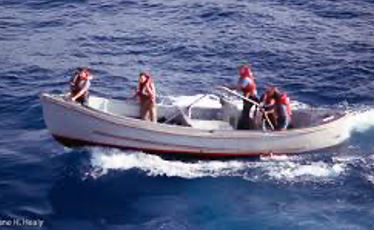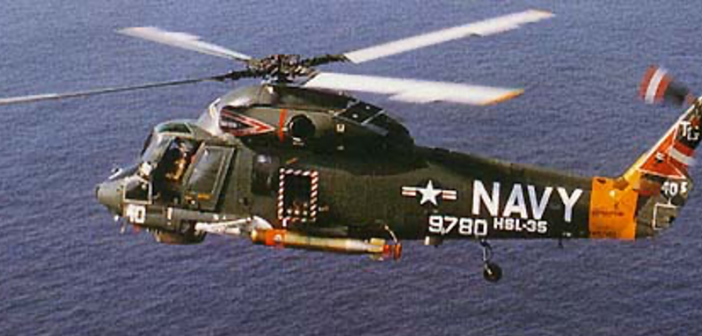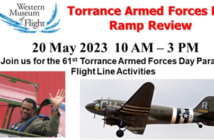Inter-ship Transfer April 1978:
While serving as Commander of the nine ship Service Squadron Four in Norfolk, VA I experienced a series of “rides” that I still vividly recall today. It all started when we received a naval message that one of our squadron ships, a “jumboised” fleet oiler, had experienced a man overboard while operating in a large-scale fleet exercise in the Caribbean. Over the next hour it was clarified that the sailor had jumped overboard and been recovered by the cruiser in a replenishment “waiting station” astern of the oiler. Then more messages: (1) a second sailor had jumped overboard, and was subsequently rescued by the cruiser [still waiting to come alongside for fuel]; (2) the first sailor informed the cruiser that he jumped to protest the deplorable conditions aboard the oiler (i.e., bad food, no air-conditioning, oppressive leaders, racial discrimination, etc., etc.); and (3) a rumor started going around that a crewman was going to jump each hour until things got better. That’s when my yeoman came in  and said “The Admiral’s on the Phone”, and I heard “Commodore, you need to get down on your ship right now!! I have arranged with [the aviation]Admiral for a plane to Naval Air Station Jacksonville leaving in an hour – be on it, and also take your Yeoman, as you are appointed to conduct a JAG (Judge Advocate General) Investigation on all this.” And so we flew in a very comfortable VIP airplane to JAX, where the aircraft carrier USS JOHN F. KENNEDY’s COD (Carrier On-board Delivery) TF-1 “Trader” was held awaiting us. We, and a full load of sailors and cargo, went out and made an arrested landing on the ship, which was part of the previously mentioned fleet exercise.
and said “The Admiral’s on the Phone”, and I heard “Commodore, you need to get down on your ship right now!! I have arranged with [the aviation]Admiral for a plane to Naval Air Station Jacksonville leaving in an hour – be on it, and also take your Yeoman, as you are appointed to conduct a JAG (Judge Advocate General) Investigation on all this.” And so we flew in a very comfortable VIP airplane to JAX, where the aircraft carrier USS JOHN F. KENNEDY’s COD (Carrier On-board Delivery) TF-1 “Trader” was held awaiting us. We, and a full load of sailors and cargo, went out and made an arrested landing on the ship, which was part of the previously mentioned fleet exercise.
Ride 1: We stayed overnight on the carrier, then boarded a CH-46 “Sea Knight” helo that would take us to the oiler. However, she was too far away, so we were to be put down on a cruiser, who during the next several hours, would be closing the oiler and would eventually use their helo to get us to the oiler. The cruiser’s flight deck was too small for the Ch-46, so nearing the cruiser the helo crewman motioned me forward toward the hatch/door, put the horse-collar over my head, had me sit on the deck at the open hatch, and positioned the hoist cable. The helo entered a hover over the flight deck and the crewman tensioned the hoist and pushed me out the door. As I was being lowered the helo started rolling right and descending – i.e., crashing! My totally reflexive action was to raise my arms, thus shucking the horse-collar, and jumping/falling several feet to the deck. I ran forward from the flight deck and didn’t stop until I had reached the cruisers bridge, where an astonished Admiral and Captain exclaimed “Where did you come from?” A short time later the Flight Deck Chief apologized to me for the push he had given me as we both ran from the flight deck – my response was definitely a “thanks!” The helo rolled right, dragged a wheel through the deck-edge safety net, ricocheted off a gun mount and large antenna, rotated 360 degrees, splashed onto the water, subsequently gained a “stabilized, rotor turning condition”, and after a couple of minutes lifted off and, trailing fuel from a split tank, went back to the carrier. I learned later that they had experienced an engine auto-throttle problem that the junior pilot in control did not respond to properly and the senior pilot aircraft commander had been unacceptably slow to intervene.
 Ride 2: The cruiser moved their SH-2 “Seasprite” helo from the hangar, cranked it up, and in due course lifted off for the oiler with me in one of the two crew seats in back. The oiler did not have a flight deck, so it would be another hoist operation. Approaching a hover, the crewman moved me forward and started to add the horse-collar when there was commotion in the cockpit. Both pilots were intensely looking at a very red warning light on the overhead console – a transmission “chips light”, indicative of metal particles in the oil and potential massive failure. The crewman shoved me back toward the seat yelling “strap in”. The pilots immediately followed emergency procedures to reduce load on the transmission, and headed directly for the cruiser, where they made a successful landing. I learned several months later that post flight inspection revealed that it had been a false indication, but impending transmission failure is an emergency you take very seriously.
Ride 2: The cruiser moved their SH-2 “Seasprite” helo from the hangar, cranked it up, and in due course lifted off for the oiler with me in one of the two crew seats in back. The oiler did not have a flight deck, so it would be another hoist operation. Approaching a hover, the crewman moved me forward and started to add the horse-collar when there was commotion in the cockpit. Both pilots were intensely looking at a very red warning light on the overhead console – a transmission “chips light”, indicative of metal particles in the oil and potential massive failure. The crewman shoved me back toward the seat yelling “strap in”. The pilots immediately followed emergency procedures to reduce load on the transmission, and headed directly for the cruiser, where they made a successful landing. I learned several months later that post flight inspection revealed that it had been a false indication, but impending transmission failure is an emergency you take very seriously.
 Ride 3: By now the cruiser and the oiler had closed and it was decided to transfer me using the oilers 25-foot motor whaleboat. The ships laid-to a hundred yards apart, the oiler put their boat in the water and it headed for the cruiser. As they approached, we observed the boats engineman lift the engine hood, drop it down and frantically signal the coxswain to head back to the oiler. They did, and immediately hooked up and were lifted clear. I learned later that the engineman had discovered a ruptured engine cooling hose that was flooding the boat. The cruiser launched their motor whale boat, which came around to the port (lee) side and in a 6-8 foot swell managed to knock the heavy metal boarding ladder up onto the deck. It was wrestled back into place, and I boarded the wildly bobbing boat. Since the oiler could not lift this boat – their davits were full – I was to climb up a wooden Pilots (Jacobs) ladder. Getting from the up-down movement of the boat onto the ladder was a matter of judging the swell, grabbing the ladder as high as I could while
Ride 3: By now the cruiser and the oiler had closed and it was decided to transfer me using the oilers 25-foot motor whaleboat. The ships laid-to a hundred yards apart, the oiler put their boat in the water and it headed for the cruiser. As they approached, we observed the boats engineman lift the engine hood, drop it down and frantically signal the coxswain to head back to the oiler. They did, and immediately hooked up and were lifted clear. I learned later that the engineman had discovered a ruptured engine cooling hose that was flooding the boat. The cruiser launched their motor whale boat, which came around to the port (lee) side and in a 6-8 foot swell managed to knock the heavy metal boarding ladder up onto the deck. It was wrestled back into place, and I boarded the wildly bobbing boat. Since the oiler could not lift this boat – their davits were full – I was to climb up a wooden Pilots (Jacobs) ladder. Getting from the up-down movement of the boat onto the ladder was a matter of judging the swell, grabbing the ladder as high as I could while  the boat was at the crest of the swell, and quickly sucking my legs up so the next rise of the boat wouldn’t crush them. The jumboised oiler had a high freeboard, and also had off loaded a lot of fuel, so it was about a 40’ climb straight up, much like scaling the wall of a four-story building. That was quite a climb! I was exceptionally happy when a few helping hands grabbed me as I swung my legs over the railing of the oiler!
the boat was at the crest of the swell, and quickly sucking my legs up so the next rise of the boat wouldn’t crush them. The jumboised oiler had a high freeboard, and also had off loaded a lot of fuel, so it was about a 40’ climb straight up, much like scaling the wall of a four-story building. That was quite a climb! I was exceptionally happy when a few helping hands grabbed me as I swung my legs over the railing of the oiler!
The events, investigation, and aftermath:
- The first jumper was a chronic “bad actor”, had been to Captains Mast several times, shirked work, seemed to demand attention, and was a constant pain/problem to his supervisors and shipmates. His complaints of bad food, poor living conditions, etc. were pretty much his making a normal Navy experience of the time traumatic. The ship was known as a decent feeder, however berthing was crowded [as were all Navy ships of the era], and the state-of-art air conditioning on older ships just could not adequately keep up in the hot/humid Caribbean. Many ships had these same problems – it’s the way seaboard life was then. He indicated his reason for jumping was a protest designed to get corrective action, and, in my opinion, him off the ship and out of the Navy. He did succeed, with disciplinary action and a less than honorable discharge. In my opinion he had somewhat carefully planned his jump: He did it in warm waters when there was a ship immediately astern that could pick him up, jumped forward of mid-ships, where the bow wave and hull pressure pattern would take him outward away from the screws, and was hanging onto a life jacket. Try as I might, I could never get clarity on this latter issue from him or anyone else onboard. However, I think that he had someone pre-planned to toss it to him, as he was holding – not wearing – it when picked up by the cruiser. And there wasn’t time enough for an un-alerted crewman to react to a “man overboard” call, reach a life jacket storage, and return to the side and toss it.
- The second jump occurred as the ship was holding the required man overboard muster after the first jumper. The Main Engine Division’s muster location was on the fantail, port side. While in ranks, a Fireman Apprentice (E-2) suddenly moved outboard, stepped up on a mooring bitt, and leaped over the rail. He was picked up by the same cruiser, who was still waiting to come alongside for refueling. He was one scared kid! He was known as a good steady worker, but not a real bright guy from the hill country, and had gained the nickname of “Shaky” due to an apparent physical disorder – he was constantly moving. When he was last home on leave his father had commented that if he ever got sick like his uncle, he would kill himself rather than go through the illness. And at mail call the day or so before he jumped, he had received a letter from his mother saying that his father was going to the doctor. In his mind he equated this to “Dad’s going to kill himself”, and while standing at muster he somehow felt he couldn’t live either and jumped. He was a good kid, albeit not too swift, and was honorably medically discharged.
- I wrote this up about ten years ago as a “Family Sea Story” file, and periodically have polished the text and added the photos. Over all the years I have on occasion wondered about the various aspects of this whole thing. Was it an over-reaction by the Admiral’s to send me, or was it great and valid concern for preventing more jumping or far worse actions on the ship? How ironical is it that actions of a single bad actor sailor put many lives in jeopardy, particularly mine? For very differing reasons, could, or should, the Navy Recruiters have recognized that neither of these individuals were good candidates for Navy service? What adverse impact on the ship’s crew did knowing that higher authority held their Captain in such low regard that the squadron commander had to personally come aboard at sea? I do know that having your Commodore climb up the side of your ship and over your life rails must have been an exceptionally humiliating, and irritating, experience for the CO.
- Over the next few years the Navy magazines Approach and Naval Aviation News had a couple of articles about the CH-46 incident in which they discussed the pilot errors, reasons there for, and provided informative procedural information. The articles always commented along the line of “somehow the passenger (me) escaped injury, leaped clear, was lowered quickly, etc.” without any definitive information. Following one of the articles, the cruisers Flight Deck Officer wrote a letter-to-the-editor indicating that he was there, saw everything, and has no idea how the passenger ended up on his flight deck. I wrote him, thanked him for the support he and his crew had been, and stated “I jumped”.
- Horse-collar. About 1983 a Naval Aviation Safety Center publication announced that a new, improved, and far safer
 horse-collar had been developed and issued for fleet use. Discussion and photos were provided. The improvement was a strap that once the horse-collar was over the head and in place under the arms, would be connected across the chest between the two vertical sides. The intent was to keep the person being lifted from somehow slipping out of the collar. I sent a letter to the Safety Center, referencing the previous articles about the CH-46 incident, noted that I was the “passenger”, and stated that had the new and improved harness with the strap been in use then I would not be here to write them. After a couple a reply came from the Safety Center. Essentially it read: “Your letter has been passed around all directorates, and read with amazement and interest. Accident history shows statistically that the strap will reduce fatalities from persons slipping out of the collar. About all that we can come up with is that you were ‘statistically having a bad day’” [emphasis added].
horse-collar had been developed and issued for fleet use. Discussion and photos were provided. The improvement was a strap that once the horse-collar was over the head and in place under the arms, would be connected across the chest between the two vertical sides. The intent was to keep the person being lifted from somehow slipping out of the collar. I sent a letter to the Safety Center, referencing the previous articles about the CH-46 incident, noted that I was the “passenger”, and stated that had the new and improved harness with the strap been in use then I would not be here to write them. After a couple a reply came from the Safety Center. Essentially it read: “Your letter has been passed around all directorates, and read with amazement and interest. Accident history shows statistically that the strap will reduce fatalities from persons slipping out of the collar. About all that we can come up with is that you were ‘statistically having a bad day’” [emphasis added].




